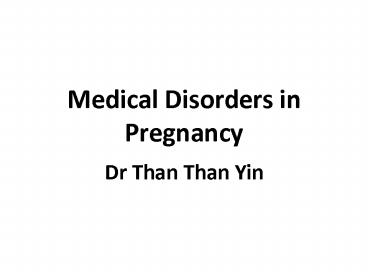Medical Disorders in Pregnancy - PowerPoint PPT Presentation
1 / 20
Title:
Medical Disorders in Pregnancy
Description:
Medical Disorders in Pregnancy Dr Than Than Yin Obstetric cholestasis Unique to pregnancy Severe pruritus affecting limbs and trunk mainly palm and sole Developing in ... – PowerPoint PPT presentation
Number of Views:1720
Avg rating:3.0/5.0
Title: Medical Disorders in Pregnancy
1
Medical Disorders in Pregnancy
- Dr Than Than Yin
2
Obstetric cholestasis
- Unique to pregnancy
- Severe pruritus affecting limbs and trunk mainly
palm and sole - Developing in the second half of pregnancy
(usually during the third trimester)
3
Diagnosis
- A typical history of pruritus without rash
- Abnormal liver function tests
- Moderate lt less than three-fold elevation in
transamimases ( ALT is the most sensitive) - Raised ALP 9gt pregnancy values
- Raised ? glutamyl transpeptidase
- Mild elevation of bilirubin
- Increased total serum bile acid
- Exclusion of other causes of itching and abnormal
liver function
4
Diagnosis
- To exclude other causes of abnormal liver
function - Liver scan
- Viral serology ( for hepatitis A,B,C and E,EBV
and CMV) - Liver autoantibodies( for pre-exisisting liver
diseasse, anti-smooth muscle antibodies,
antimitochondrial antibodies
5
Management
- Counselling
- Weekly LFT and bile acids
- No evidence of monitoring fetal well-being
- To check prothrombin time prior to delivery
6
Intrapartum management
- Labour may be induced at 37-38 weeks gestation if
persistantly raised bile acid levels - If bile acid levels lt 40 µmol/L, reasonable to
await spontaneous onset of labour
7
Drug therapy
- Vitamin K mandatoroy for women with prolonged
prothrombin time, commenced at 32 weeks - Antihistamine
- Ursodeoxycholic acid
- Dexamethasone
- Rifampicin
- Cholestyramine
- S-Adenosylmethionine
- Activated charcol
- Epomediol
8
Diagnosis
- BP, urinalysis, uric acid, platelet count,
clotting screen, blood film - Blood glucose, serum calcium, sodium, liver
function tests - CT or MRI
- EEG
9
Epilepsy in pregnancy
- Many cases are idiopathic
- 30 have a family history of epilepsy
- Secondary Epilepsy
- Previous surgery
- Intracranial mass or lesions
- Antiphospholipid syndrome
10
Effect of pregnancy on epilepsy
- A common indirect maternal death
- No effect in majority
- Women who have been seizure free for years are
unlikely to have seizures in pregnancy - Women with multiple type seizures are more
likely to have increase in seizure frequency - The risk of seizures is highest in peripartum
- Sudden Unexplained Death in Pregnancy (SUDEP)-
risk factors - seizure frequency
- Increasing number of antiepileptic drugs
- Low IQ
- Early onset epilepsy
11
Effect of epilepsy on pregnancy
- The fetus is relatively resistant to short
periods of hypoxia - No increased risk of miscarriage or obstetric
complications - Status epilepticus is dangerous for both mother
and fetus - The risk of child developing epilepsy is
increased (4-5) if either parent has epilepsy
and, risk is 10-15 if both parents have
epilepsy, 10 risk with previously effected
sibling
12
Teratogenic risk of anti-epileptic drugs(AED)
- Phenytoin, primidone, phenobarbitone,
carbamazepine, sodium valproate, lamotrigine,
topiramate and levetiracetam all cross the
placenta and are teratogenic - Major malformations caused by AEDs
- Neural tube defects ( especially valproates
1-3.8 and carbamazepine 0.5-1) - Orofacial clefts ( particularly Phenytoin,
carbamazepine, phenobarbitone and valproate) - Congenital heart defects (particularly Phenytoin,
phenobarbitone and valproate) - Minor malformations
- Dysmorphic features
- Hypertelorism
- Hypoplastic nails and distal digits
- Hypoplasia of the mid face
13
Teratogenic risk of anti-epileptic drugs(AED)
- Metaanalysis of all studies showed that the risk
of any one drug is approximately 6-7 - Various theories
- Genetic deficiency of the detoxifying enzyme
epoxide hydrolase - Cytotxic free radicals
- Folic acid deficiency
14
Management
- Antenatal management
- Folic acid 5mg daily
- No need to change the AED if epilepsy is well
controlled - Pre-natal screening for congenital abnormalities
and detailed ultrasound at 18-20 weeks should be
ordered, including fetal cardiac assessment - Vitamin A 10-20mg daily should be prescribed in
the last four weeks of pregnancy - Intrapartum management
- Risk of seizures increase around the time of
delivery - 1-2 will have a seizure during labour and 1-2
will have a seizure in post partum 24 hours
period - Should continue regular AED
- Effective pain relief and epidural analgesia
- Postnatal management
- The neonate should recieve 1mg Vitamin K Inj IM
- Breast feeding should be encouraged
15
Cardiac disease in pregnancy
- Leading cause of maternal death as result of
- Myocardial infarction
- Ischemic heart disease
- Dissecting aortic aneurism
- Other heart disease
- Peripartum cardiomyopathy
- Rheumatic heart disease- 25 of pregnant
population who not born in the UK - Congenital heart disease
16
Management
- Preconception counselling
- Antepartum
- Risk assessment
- Joint clinic attended by obstetrician,
cardiologist, anaesthetist - Echocardiogram
- Fetal echocardiogram for women with congenital
cardiac disease - 32-34 weeks gestation multidisciplinary meeting
for birth plan - Intrapartum
- Early slow incremental epidural analgesia,
assisted vaginal delivery - Caesarean section is only necessary for obstetric
indications - Postpartum
- Anticoagulation
- Long observation in high dependency area
- Prophylaxis against postpartum haemorrhage
- Low dose oxytocin infusion
17
Thyroid disease in pregnancy
- Hyperthyroidism
- Hyperthyroidism
- Thyrotoxicosis complicates in 1 in 500
pregnancies - 50 of affected women have a positive family
history of autoimmune thyroid disease - 95 are due to Graves disease, an autoimmune
disorder caused by TSH receptor stimulating
antibodies
- 1 of pregnancies
- Most cases have already been diagnosed
- Associated with autoimmune diseases, pernicious
anemia, vitiligo, type 1 diabetes - Commonest causes encountered in pregnancy-
Hashimotos thyroiditis, treated Graves disease
18
Pregnancy specific normal ranges
TSH(MU/l) Throxine (pmol/L) Triiodothyronine (pmol/L)
Non-pregnant 0.27-4.2 12-22 3.1-6.8
1st trimester 0-5.5 10-16 3-7
2nd trimester 0.5-3.5 9-15.5 3-5.5
3rdt trimester 0.5-4 8-14.5 2-5.5
19
(No Transcript)
20
(No Transcript)































